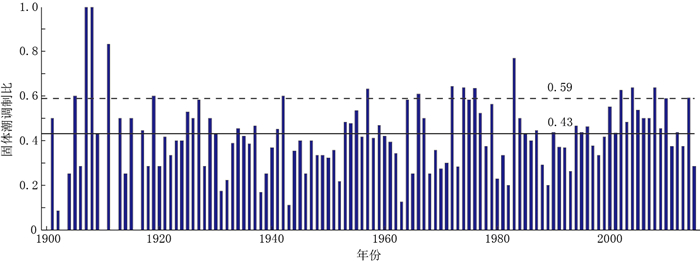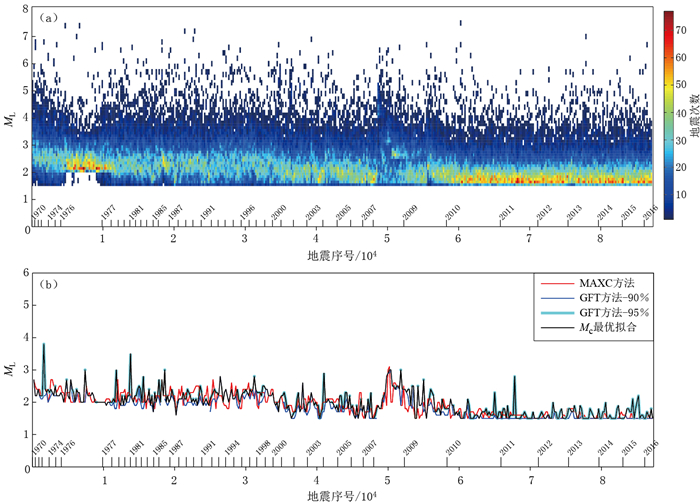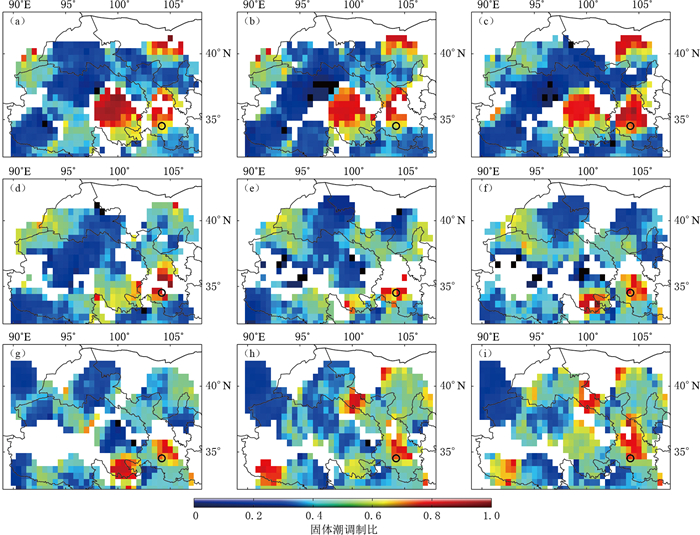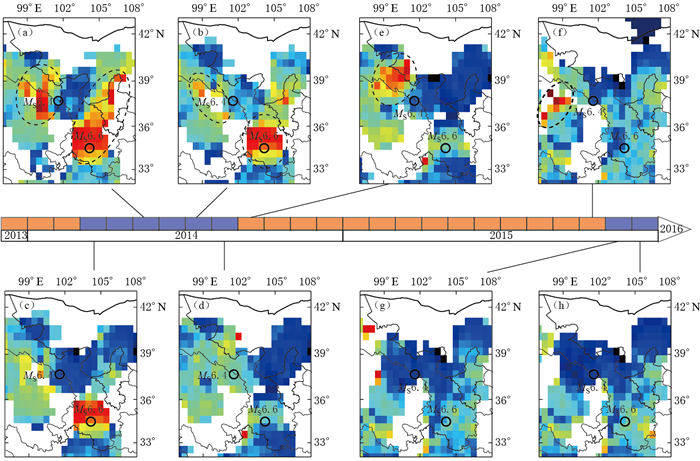The spatio-temporal characteristics of earth tide modulation ratio before moderate earthquakes in northwest China
-
摘要: 基于1900—2015年中国大陆地区浅源地震阴历目录,依据地震活跃特征确定固体潮调制阴历日期和调制比阈值,并利用固体潮调制比时空扫描方法回顾性地研究近年来西北地区发生的3次中强地震,即2013年甘肃岷县漳县MS6.6、2015年内蒙古阿拉善MS5.8和2016年青海门源MS6.4地震前, 区域小震的固体潮调制比时空演化过程.研究结果显示:岷县漳县MS6.6和阿拉善MS5.8地震前震中区域出现固体潮调制比异常,门源MS6.4地震前震中附近的固体潮调制比异常演化时间较长; 西北地区3次中强震均发生在固体潮调制比时空扫描的高值异常集中地区及周围区域,扫描时间窗长度和固体潮调制比异常区域的大小可能与中强震的强度有一定的相关性.
-
关键词:
- 固体潮调制比 /
- 阿拉善MS5.8地震 /
- 岷县漳县MS6.6地震 /
- 门源MS6.4地震
Abstract: Based on the shallow-focus earthquakes lunar catalog in Chinese mainland from 1900 to 2015, modulated lunar date and threshold of modulation ratio are defined respectively according to seismic active characteristics. The modulation ratio method is employed to carry out spatio-temporal scanning for three moderate earthquakes in northwest China, and the spatio-temporal characteristics of modulation ratio of regional small earthquakes are analyzed. Results indicate that there are modulation ratio anomalies around epicentral area before Minxian-Zhangxian MS6.6 earthquake and Alxa MS5.8 earthquake, evolution time of modulation ratio anomaly is relatively long for Menyuan MS6.4 earthquake. All three moderate earthquakes happened around the area with higher earth tide modulation ratio according to the spatio-temporal scanning results, and the length of time window and the abnormal area size of the earth tide modu-lation ratio may have correlations with the magnitude of moderate earthquakes. -
引言
引潮力是月球和太阳对地球上单位质量物体的引力和地球绕地月公共质心旋转时所产生的惯性离心力的合力.有研究表明,引潮力对地震活动有触发和调制作用(吴小平等, 1999; 张国民等, 2001; Tanaka et al, 2004, 2006; 张晶等, 2007; 蒋海昆, 2010; 汪翠枝等, 2010; 李金,蒋海昆, 2011a, b; 孙长青等, 2014; 解朝娣等, 2015).固体潮是地球在日、月引潮力作用下产生的周期性形变现象, 其在地球内部产生的周期性应力,即固体潮汐应力,虽然比地震应力降小很多(数量级约为103 Pa),但是其累积速率却比构造应力大两个数量级(Heaton, 1975, 1982).同时,潮汐应力具有对地球内同一部位不断重复作用的特点,而这种潮汐的振荡性质而非潮汐振幅,在潮汐应力触发中可能起到更重要的作用(Lockner,Beeler, 1999).
针对地震与潮汐触发之间关系的研究主要集中在3个方面:一是研究地震活动与月相的对应关系(秦保燕等, 1986; 杜品仁,徐道一, 1989; 王炜等, 2001; 张国民等, 2001; 蒋海昆等, 2008);二是研究震源处的潮汐应力对发震断层的触发作用(高锡铭等, 1981; 吴小平等, 1999, 2005; 张晶等, 2007; 解朝娣等, 2015);三是利用统计学方法分析发震时刻固体潮汐周期、相位的分布特征(Schuster, 1897; Tanaka et al, 2004; 李金,蒋海昆, 2011a, b).第一种方法主要研究某一区域内的地震本身受到调制触发作用的程度,以及地震发生前震中附近小震的调制异常特征.该方法虽然只用简单的统计方法来获得地震活动的调制特征,但许多研究结果却显示该方法更加直观有效(蒋海昆, 2010; 李金,蒋海昆, 2011a).后两种方法在研究潮汐应力的触发作用时,震源机制解的完整性是保证计算结果准确的重要前提.实际应用中,在收集小震的震源机制解和确定真实的发震断层节面方面存在难度,并且不同研究人员给出的震源机制解结果的统一性和可比性较差(李金,蒋海昆, 2011a).
在关于地震与固体潮调制相关性的研究中,分析地震发震时刻与月相之间关系的方法较为普遍,例如:秦保燕等(1983, 1986)提出了小震调制比的概念,即受固体潮调制的地震次数与地震总次数的比值,并将震源处于不稳定时由于外因多次触发震源、最后导致大震的模式称为调制模式,认为将调制比随时间的变化作为地震发生的前兆信息是有意义的;张国民等(2001)主要针对我国大陆地区MS≥7.0强震受潮汐力调制触发作用的影响进行了研究,结果表明这种调制触发作用主要表现为对活跃期内MS≥7.0强震的调制触发.此外,多位研究人员分别采用中等调制地震、调制地震频次、调制小震的非稳态短期异常特征及震中附近地区的小震调制比时间序列相结合等方法进行强震预测研究(张晓东,秦保燕, 1995, 2000; 谷光裕等, 1999; 王炜等, 2001; 王慧敏等, 2004; 汪翠枝等, 2010),结果表明,地震的调制特征对中强地震预报具有一定意义.
为研究西北地区中强震发生前固体调制特征,本文首先对1900年以来中国大陆地区MS≥5.0浅源地震目录进行阴历日期转换,得到对应的阴历地震目录;然后以不同起始时间、不同震级下限分别统计地震活动阴历日频次,给出固体潮调制阴历日期;再依据调制比的定义对1900年以来的年调制比进行统计分析,确定调制比阈值;最后进一步利用固体潮调制比时空扫描方法确定2013年7月22日岷县漳县MS6.6、2015年4月15日阿拉善MS5.8和2016年1月12日门源MS6.4地震发生前固体潮调制比出现高值的具体区域.
1. 资料选取与分析
1.1 资料选取
依据中国地震台网中心MS≥4.7历史强震目录,在不考虑远海及境外地震的情况下,选取1900年1月1日至2015年12月31日中国大陆地区MS≥5.0浅源地震目录. 符合条件的地震共2260次,进一步筛除30次无明确发震日期的早期地震,并去掉11次MS≥7.0的强余震和双震,最终得到1900年至2015年MS≥5.0浅源地震共2 219次,其中MS5.0—5.9地震1 747次,MS6.0—6.9地震409次,MS7.0—7.9地震55次,MS≥8.0地震8次.
1.2 调制阴历日期
朔、望、上弦和下弦的概念最早由天文学家根据日、地、月三者的4个特殊相对位置关系给出.天文学中通常认为月相中的朔、望分别对应阴历的初一和十五,上、下弦分别对应阴历的初七、初八和廿二、廿三.前文提到的固体潮即为在日、月引潮力作用下固体地球的周期性形变.在朔、望两个月相期间,日、月的引潮力较大,在此期间发生的地震可能受到较显著的固体潮调制作用的影响(杜品仁,徐道一,1989).
张国民等(2001)通过统计我国大陆地区MS7.0强震的阴历日期分布认为, 该分布中的4个峰值区分别对应朔、望日和上、下弦,其中朔对应廿八至初二,望对应十五至十七,上弦对应初八和初九,下弦对应廿二至廿五,共14天,占全月时长的46.7%;秦保燕等(1983)选择引潮力最大时段作为调制阴历时段,即朔日前后4天,望日前后4天,共计8天,占全月时长的26.7%,并定义发生在此8天内的小震为调制小震;王炜等(2001)在将小震调制比应用于华北地震中期预报的过程中,将上述8天调制时段扩展为对称于朔望的10天,即取阴历廿九至初三、十三至十七为调制阴历时段,共计10天,占全月时长的33.3%.
综上,针对固体潮调制阴历日期的选取问题主要集中在两个方面:一是选择引潮力较大的时段,主要为朔、望的前后4天,或者考虑对称性选择朔、望的前后5天;二是利用统计方法确定地震活动集中的阴历时段(秦保燕等, 1986; 张晓东,秦保燕, 2000; 王炜等, 2001;张国民等, 2001).本研究基于1900年至2015年中国大陆地区2 219次MS≥5.0浅源地震的调制特征进行了深入的统计和分析.首先对发震日期进行公历到阴历的时间转换,得到中国大陆地区浅源地震的阴历地震目录;之后分别以1900,1950和1970年为起始时间,以MS5.0,MS6.0和MS7.0为震级下限统计地震活动阴历日频次,从而确定地震活跃的阴历时段,即固体潮调制阴历日期(图 1);最后将计算的阴历日频次平均值加上一倍标准差作为此次统计的日频次异常值,将日频次超过该值的阴历日期作为此次统计的地震活跃阴历日期,统计结果列于表 1.可见地震集中发震时段为:阴历初一和初二,初八和初九,十五和十六,以及廿四和廿五.本文在确定固体潮调制阴历日期的过程中,考虑到固体潮引潮力比较平缓,因此在调制阴历时段的选取上稍作延长.重新给出的调制阴历时段为初一和初二(朔),初七至初九(上弦),十五至十七(望),廿二至廿五(下弦),共计12天,占全月时长的40%,下文中提到的调制阴历日期均与此相同.
![]() 图 1 1900 (a),1950 (b)和1970 (c)年以来中国大陆地区阴历日期地震日频次分布实线为日频次平均值, 虚线为平均值加上一倍标准差,下同Figure 1. Lunar calendar earthquake daily frequency statistics in Chinese mainland since 1900 (a), 1950 (b) and 1970 (c)Solid lines indicate the mean value of lunar calendar earthquake daily frequency, dashed lines indicate the sum of mean and standard deviation, the same below表 1 1900年以来中国大陆MS≥5.0地震活跃阴历日期Table 1. Statistics of seismic active period for MS≥5.0 earthquakes in Chinese mainland
图 1 1900 (a),1950 (b)和1970 (c)年以来中国大陆地区阴历日期地震日频次分布实线为日频次平均值, 虚线为平均值加上一倍标准差,下同Figure 1. Lunar calendar earthquake daily frequency statistics in Chinese mainland since 1900 (a), 1950 (b) and 1970 (c)Solid lines indicate the mean value of lunar calendar earthquake daily frequency, dashed lines indicate the sum of mean and standard deviation, the same below表 1 1900年以来中国大陆MS≥5.0地震活跃阴历日期Table 1. Statistics of seismic active period for MS≥5.0 earthquakes in Chinese mainland统计震级及日期范围 地震活跃的阴历日期 朔 上弦 望 下弦 MS≥5.0 初二 初八 — — 1900年以来 MS≥6.0 廿九、初一、初二 初八 十五 廿一 MS≥7.0 初二 初八、初九 — 廿四 MS≥5.0 初二、初三 初八 十六、十七 — 1950年以来 MS≥6.0 初一、初二、初三 初八 — 廿一 MS≥7.0 初一、初二 初九 十五 — MS≥5.0 初二 初八 十六 — 1970年以来 MS≥6.0 初一、初二 初八 十三 廿五 MS≥7.0 初一、初二 初八、初九 十五 廿四 1.3 固体潮调制比
若某一区域出现固体潮调制比高值异常,则表明该地区的应力可能已处于临界状态,该地区及附近区域未来可能发生地震(张国民等, 2001; 陈荣华等, 2006).在确定固体潮调制比异常区域前,需要首先明确调制比的异常阈值.本文基于前文给出的固体潮调制阴历日期,统计了自1900年以来每一自然年内中国大陆地区MS≥5.0地震的固体潮调制比(图 2),据此计算出年调制比的平均值加一倍标准差为0.59,即为固体潮调制比的异常阈值.
2. 西北地区固体潮调制比的时空特征
我国西北地区(32°N—42°N, 90°E—108°E)包含了青藏高原东北缘的大部分地区,而青藏高原东北缘是青藏高原向大陆内部扩展的前缘部位,处于板块碰撞最强烈区域的边缘(Kind,Yuan, 2010;Zhang et al,2013). M7专项工作组(2012)指出,西北地区所包含的南北地震带中、北段在未来十年及稍长时间里存在发生MS≥7.0大地震的危险性.近年来西北地区发生的3次中强地震,即岷县漳县MS6.6、阿拉善MS5.8和门源MS6.4地震,其震中区域附近震前均存在较为显著的调制地震集中现象(图 3).
![]() 图 3 基于调制阴历日期的3次中强地震前调制及非调制地震空间分布图(a) 2012-07-01—2013-06-30岷县漳县MS6.6地震前; (b) 2014-10-15—2015-04-14阿拉善MS5.8地震前; (c) 2014-10-01—2015-09-30门源MS6.4地震前Figure 3. Distribution of modulated and unmodulated earthquakes before three moderate earthquakes(a) 2012-07-01—2013-06-30 before Minxian-Zhangxian MS6.6 earthquake; (b) 2014-10-15—2015-04-14 before Alxa MS5.8 earthquake; (c) 2014-10-01—2015-09-30 before Menyuan MS6.4 earthquake
图 3 基于调制阴历日期的3次中强地震前调制及非调制地震空间分布图(a) 2012-07-01—2013-06-30岷县漳县MS6.6地震前; (b) 2014-10-15—2015-04-14阿拉善MS5.8地震前; (c) 2014-10-01—2015-09-30门源MS6.4地震前Figure 3. Distribution of modulated and unmodulated earthquakes before three moderate earthquakes(a) 2012-07-01—2013-06-30 before Minxian-Zhangxian MS6.6 earthquake; (b) 2014-10-15—2015-04-14 before Alxa MS5.8 earthquake; (c) 2014-10-01—2015-09-30 before Menyuan MS6.4 earthquake2.1 固体潮调制比时空扫描
基于中国地震台网中心给出的全国ML≥3.0地震目录,利用固体潮调制比时空扫描方法对选定区域进行时空扫描,统计每个时空窗范围内的调制和非调制地震目录.在固体潮调制比时空扫描过程中,对地震目录的最小完整性震级Mc进行科学评估是保证扫描结果稳定性的重要基础,本研究采用震级-序号法和定量的多统计方法评估Mc,评估结果(图 4)显示西北地区的最小完整性震级为ML3.0(蒋长胜等, 2013).
针对选定的时空窗范围进行固体潮调制比时空扫描,从而得到调制比的时空演化图像.扫描过程中选定的时空窗口内,地震次数的下限值为5,若不满足该下限则不进行调制比计算.具体扫描参数设定为:①地震目录的震级下限为ML3.0;②时间窗长为6个月,当区域地震活动较弱时,可参考1年窗长的调制比结果;时间扫描步长为1个月,如果演化时间较长可选为3个月;③空间窗口半径为150 km,空间扫描步长为0.5°×0.5°.
2.2 西北地区中强地震前调制比时空演化特征
2.2.1 2013年岷县漳县MS6.6地震
2013年7月22日07:45,在甘肃省定西市岷县、漳县交界处(34.5°N, 104.2°E)发生MS6.6地震,震源深度约为20 km,发震断层为临潭—宕昌断裂.根据矩张量反演结果,该地震为一次带走滑分量的逆冲型地震(孙蒙等, 2015).自1900年以来,该地震震中附近100 km范围内共发生MS≥5.0地震8次,最大地震为1987年1月8日甘肃迭部MS5.8地震.从岷县漳县地震震前1年内ML≥3.0地震的空间分布可以看出,震中区域发生的地震多为调制地震,且分布相对集中(图 3a).
在岷县漳县MS6.6地震发生前两年,震中区附近出现调制比高值异常区,2011年底异常区域调制现象变得更加显著,随后2012年初有所减弱,且调制比高值异常区域变小,至岷县漳县MS6.6地震发生前,调制比异常区域范围有所扩大,整体演化过程持续近两年,在此期间虽然调制现象显著程度和异常区域大小有所调整,但是从整个调制比时空演化过程来看连续性较好(图 5).
![]() 图 5 2013年岷县漳县MS6.6地震前后固体潮调制比时空演化过程Figure 5. The spatio-temporal evolution of earth tidal modulation ratio before and after the 2013 Minxian-Zhangxian MS6.6 earthquake(a) 2010-07-01—2011-06-30; (b) 2010-10-01—2011-09-30; (c) 2011-01-01—2011-12-31; (d) 2011-04-01—2012-03-31; (e) 2011-07-01—2012-06-30; (f) 2011-10-01—2012-09-30; (g) 2012-01-01—2012-12-31; (h) 2012-04-01—2013-03-31; (i) 2012-07-01—2013-06-30
图 5 2013年岷县漳县MS6.6地震前后固体潮调制比时空演化过程Figure 5. The spatio-temporal evolution of earth tidal modulation ratio before and after the 2013 Minxian-Zhangxian MS6.6 earthquake(a) 2010-07-01—2011-06-30; (b) 2010-10-01—2011-09-30; (c) 2011-01-01—2011-12-31; (d) 2011-04-01—2012-03-31; (e) 2011-07-01—2012-06-30; (f) 2011-10-01—2012-09-30; (g) 2012-01-01—2012-12-31; (h) 2012-04-01—2013-03-31; (i) 2012-07-01—2013-06-302.2.2 2015年阿拉善MS5.8地震
2015年4月15日15时39分,内蒙古阿拉善左旗(39.8°N, 106.5°E)发生MS5.8地震,震源深度为10 km,震中位于磴口—本井断裂附近.根据矩张量反演结果,该地震为略带逆冲分量的走滑型地震(韩晓明等, 2015).自1900年以来,该地震震中附近100 km范围内共发生MS≥5.0地震4次,最大地震为1976年9月23日内蒙古阿拉善左旗MS6.2地震.阿拉善MS5.8地震发生前的半年内,虽然在震中附近地区ML≥3.0地震相对较少,但是周边发生的地震均为调制地震,调制现象比较突出(图 3b).
阿拉善MS5.8地震发生前两个月,在宁夏北部地区出现小范围的固体潮调制比高值异常现象,该现象持续两个月后在异常区域内发生了此次地震,震后调制比异常现象消失.在整个固体潮调制比的时空演化过程中,调制异常的显著程度和异常区域大小无显著变化,且调制比异常持续时间较短,约两个月左右(图 6).
2.2.3 2016年门源MS6.4地震
2016年1月21日1时13分,青海门源(37.7°N, 101.6°E)发生MS6.4地震,震源深度为10 km,震中位于祁连山地震带东段的冷龙岭断裂带附近.根据矩张量反演结果,该地震为一次逆冲型地震事件(胡朝忠等, 2016).自1900年以来,该地震震中附近100 km范围内共发生MS≥5.0地震22次,最大地震为1927年5月23日古浪MS8.0地震. 图 3c为西北地区2014年10月1日至2015年9月30日,即门源地震发生前1年至发生前3个月, ML≥3.0地震的空间分布,可以看出,青海中北部地区调制地震分布相对集中.
门源地震发生前2.7年左右,震中区附近出现调制比高值异常现象,2013年9月末,该异常区域发生南向调整,且高值异常现象于2014年3月末至6月减弱,直至9月末逐渐增强,且调制异常区域显著增大,至2015年6月末,调制比异常区域又有所减小, 至震前两个月左右,调制比异常现象消失,2016年1月21日发生门源MS6.4地震.此次地震前调制比演化时间较长,调制比异常表现为起伏发展,而非持续存在,呈现减弱后显著增强,随后又减弱的过程(图 7).
![]() 图 7 2016年门源MS6.4地震前固体潮调制比时空演化过程Figure 7. The spatio-temporal evolution of earth tidal modulation ratio before 2016 Menyuan MS6.4 earthquake(a) 2012-04-01—2013-03-31; (b) 2012-07-01—2013-06-30; (c) 2012-10-01—2013-09-30; (d) 2013-01-01— 2013-12-31; (e) 2013-04-01—2014-03-31; (f) 2013-07-01—2014-06-30; (g) 2013-10-01—2014-09-30; (h) 2014-01-01—2014-12-31; (i) 2014-04-01—2015-03-31; (j) 2014-07-01—2015-06-30; (k) 2014-10-01—2015-09-30; (l) 2015-01-01—2015-12-31
图 7 2016年门源MS6.4地震前固体潮调制比时空演化过程Figure 7. The spatio-temporal evolution of earth tidal modulation ratio before 2016 Menyuan MS6.4 earthquake(a) 2012-04-01—2013-03-31; (b) 2012-07-01—2013-06-30; (c) 2012-10-01—2013-09-30; (d) 2013-01-01— 2013-12-31; (e) 2013-04-01—2014-03-31; (f) 2013-07-01—2014-06-30; (g) 2013-10-01—2014-09-30; (h) 2014-01-01—2014-12-31; (i) 2014-04-01—2015-03-31; (j) 2014-07-01—2015-06-30; (k) 2014-10-01—2015-09-30; (l) 2015-01-01—2015-12-313. 讨论与结论
本研究重新给出了固体潮调制阴历日期,具体为初一和初二、初七至初九,十五至十七,廿二至廿五,共计12天,占全月时长的40%;同时根据固体潮调制比的定义,给出了固体潮调制比的异常阈值为0.59;利用固体潮调制比时空扫描方法对3次中强地震震前区域小震的调制比时空演化特征进行了回顾性研究,明确了西北地区3次中强震前其震中及周围区域均出现了固体潮调制比高值异常现象.
在固体潮调制比异常的时间演化特征方面,岷县漳县MS6.6地震的异常演化时间约为两年,阿拉善MS5.8地震的异常演化时间约为两个月,门源MS6.4地震的异常演化时间则约为2.7年.门源地震的固体潮调制比在演化地程中出现的异常位置调整和强度减弱等现象可能与岷县漳县地震及其余震对西北地区应力场的调整作用有关,这两次地震的固体潮调制比演化关系的时间进程如图 8所示.
![]() 图 8 岷县漳县MS6.6地震和门源MS6.4地震的固体潮调制比演化时间进程对比虚线范围为固体潮调制比异常区域Figure 8. The comparison of spatio-temporal evolution of earth tide modulation ratio of Minxian-Zhangxian MS6.6 earthquake with that of Menyuan MS6.4 earthquakeDashed ellipses indicate the abnormal areas with high modulation ratio
图 8 岷县漳县MS6.6地震和门源MS6.4地震的固体潮调制比演化时间进程对比虚线范围为固体潮调制比异常区域Figure 8. The comparison of spatio-temporal evolution of earth tide modulation ratio of Minxian-Zhangxian MS6.6 earthquake with that of Menyuan MS6.4 earthquakeDashed ellipses indicate the abnormal areas with high modulation ratio
(a) 2013-01-01—2013-12-31; (b) 2013-03-01—2014-02-28; (c) 2013-04-01—2014-03-31; (d) 2013-09-01—2014-08-31; (e) 2013-10-01—2014-09-30; (f) 2014-11-01—2015-10-31; (g) 2014-12-01—2015-11-30; (h) 2015-01-01—2015-12-31由图 8可见,岷县漳县MS6.6地震和门源MS6.4地震前在震中附近地区均出现调制比高值异常区域,阿拉善MS5.8地震也发生在调制比高值异常区域.虽然在岷县漳县MS6.6地震和门源MS6.4地震前,调制比异常区域的大小有所调整,但这3次地震均发生在固体潮调制比时空扫描的高值异常集中地区或周围区域.选取震级下限为ML3.0的地震目录进行固体潮调制比时空扫描,可观察到3次中强震前在震中区附近均存在固体潮调制比高值异常现象,表明该时空扫描方法中所选地震目录的震级下限与未来该地区中强震的相关性较好.
固体潮调制比时空扫描计算中,影响调制比扫描结果的因素较多,如时空窗长、滑动时空步长、窗口内地震次数下限及所选地震目录震级下限等.其中,时空窗内的样本数,即地震次数,是影响调制比结果的主要因素之一,如果样本数过少,则无法保证统计结果的合理性,反之则会导致原本可能存在的固体潮调制特征被数据的平均效应所掩盖.
在时空扫描时间窗长的选取方面,岷县漳县地震和门源地震时间窗长选取为1年时,固体潮调制比异常现象比较显著,阿拉善地震时间窗长选取为6个月时,调制比异常现象较显著.此外,岷县漳县地震和门源地震前在震中及周围地区出现的调制比异常区域范围相对较大,阿拉善地震前在震中区出现的调制比异常区域则较小,表明扫描时窗长度和调制比异常区域的大小可能与未来中强震的强度有关.关于固体潮调制比异常的持续时间,目前尚未得到较为明确的认识,例如门源地震的调制比演化中出现的调制比异常位置调整和强度减弱或增强等现象,尤其是在震前两个月左右调制比异常消失的情况,在后续工作中尚需针对更多震例进行分析检验.
综上所述,依据重新给出的固体潮调制阴历日期及调制比异常阈值,可以较好地呈现固体潮调制比异常的时空演化特征;固体潮调制比时空扫描方法的震级下限为ML3.0;固体潮调制比高值异常区域在反映了该区域应力增强的同时,也可被认为是未来中强震可能的发震地点.因此中强震前固体潮调制比异常能够为理解地震活动与固体潮的相关性提供一定的参考依据.
中国地震台网中心蒋海昆研究员在论文撰写过程中给予了指导并进行了有益的讨论,中国地震台网中心预报部测震组亦给予了支持和帮助,作者在此一并表示感谢! -
图 1 1900 (a),1950 (b)和1970 (c)年以来中国大陆地区阴历日期地震日频次分布
实线为日频次平均值, 虚线为平均值加上一倍标准差,下同
Figure 1. Lunar calendar earthquake daily frequency statistics in Chinese mainland since 1900 (a), 1950 (b) and 1970 (c)
Solid lines indicate the mean value of lunar calendar earthquake daily frequency, dashed lines indicate the sum of mean and standard deviation, the same below
图 3 基于调制阴历日期的3次中强地震前调制及非调制地震空间分布图
(a) 2012-07-01—2013-06-30岷县漳县MS6.6地震前; (b) 2014-10-15—2015-04-14阿拉善MS5.8地震前; (c) 2014-10-01—2015-09-30门源MS6.4地震前
Figure 3. Distribution of modulated and unmodulated earthquakes before three moderate earthquakes
(a) 2012-07-01—2013-06-30 before Minxian-Zhangxian MS6.6 earthquake; (b) 2014-10-15—2015-04-14 before Alxa MS5.8 earthquake; (c) 2014-10-01—2015-09-30 before Menyuan MS6.4 earthquake
图 5 2013年岷县漳县MS6.6地震前后固体潮调制比时空演化过程
Figure 5. The spatio-temporal evolution of earth tidal modulation ratio before and after the 2013 Minxian-Zhangxian MS6.6 earthquake
(a) 2010-07-01—2011-06-30; (b) 2010-10-01—2011-09-30; (c) 2011-01-01—2011-12-31; (d) 2011-04-01—2012-03-31; (e) 2011-07-01—2012-06-30; (f) 2011-10-01—2012-09-30; (g) 2012-01-01—2012-12-31; (h) 2012-04-01—2013-03-31; (i) 2012-07-01—2013-06-30
图 7 2016年门源MS6.4地震前固体潮调制比时空演化过程
Figure 7. The spatio-temporal evolution of earth tidal modulation ratio before 2016 Menyuan MS6.4 earthquake
(a) 2012-04-01—2013-03-31; (b) 2012-07-01—2013-06-30; (c) 2012-10-01—2013-09-30; (d) 2013-01-01— 2013-12-31; (e) 2013-04-01—2014-03-31; (f) 2013-07-01—2014-06-30; (g) 2013-10-01—2014-09-30; (h) 2014-01-01—2014-12-31; (i) 2014-04-01—2015-03-31; (j) 2014-07-01—2015-06-30; (k) 2014-10-01—2015-09-30; (l) 2015-01-01—2015-12-31
图 8 岷县漳县MS6.6地震和门源MS6.4地震的固体潮调制比演化时间进程对比
虚线范围为固体潮调制比异常区域
Figure 8. The comparison of spatio-temporal evolution of earth tide modulation ratio of Minxian-Zhangxian MS6.6 earthquake with that of Menyuan MS6.4 earthquake
Dashed ellipses indicate the abnormal areas with high modulation ratio
(a) 2013-01-01—2013-12-31; (b) 2013-03-01—2014-02-28; (c) 2013-04-01—2014-03-31; (d) 2013-09-01—2014-08-31; (e) 2013-10-01—2014-09-30; (f) 2014-11-01—2015-10-31; (g) 2014-12-01—2015-11-30; (h) 2015-01-01—2015-12-31表 1 1900年以来中国大陆MS≥5.0地震活跃阴历日期
Table 1 Statistics of seismic active period for MS≥5.0 earthquakes in Chinese mainland
统计震级及日期范围 地震活跃的阴历日期 朔 上弦 望 下弦 MS≥5.0 初二 初八 — — 1900年以来 MS≥6.0 廿九、初一、初二 初八 十五 廿一 MS≥7.0 初二 初八、初九 — 廿四 MS≥5.0 初二、初三 初八 十六、十七 — 1950年以来 MS≥6.0 初一、初二、初三 初八 — 廿一 MS≥7.0 初一、初二 初九 十五 — MS≥5.0 初二 初八 十六 — 1970年以来 MS≥6.0 初一、初二 初八 十三 廿五 MS≥7.0 初一、初二 初八、初九 十五 廿四 -
陈荣华, 薛艳, 郑大林, 丁香. 2006.引潮力对显著地震触发作用与大震关系的机理讨论[J].地震, 26(1): 66-70. http://d.wanfangdata.com.cn/Periodical/diz200601009 Chen R H, Xue Y, Zheng D L, Ding X. 2006. Discussion on mechanism concerning relation between tidal force triggering of significant shocks and large earthquakes[J]. Earthquake, 26(1): 66-70 (in Chinese). http://d.wanfangdata.com.cn/Periodical/diz200601009
杜品仁, 徐道一. 1989.天文地震学引论[M].北京:地震出版社: 124-156. Du P R, Xu D Y. 1989. Astroseismology Introduction[M]. Beijing: Seismological Press: 124-156 (in Chinese).
高锡铭, 殷志山, 王威中, 黄利娟, 李建. 1981.固体潮应力张量对地震的触发作用[J].地震学报, 3(3): 264-275. http://www.dzxb.org/Magazine/Show?id=27929 Gao X M, Yin Z S, Wang W Z, Huang L J, Li J. 1981. Triggering of earthquakes by the tidal stress tensor[J]. Acta Seismologica Sinica, 3(3): 264-275 (in Chinese). http://www.dzxb.org/Magazine/Show?id=27929
谷光裕, 王玉莹, 赵振, 孙文福. 1999.固体潮高时段地震活动特征与小震调制比Rm异常的判定[J].东北地震研究, 15(4): 9-17. http://www.cqvip.com/Main/Detail.aspx?id=5127002 Gu G Y, Wang Y Y, Zhao Z, Sun W F. 1999. The characteristics of seismicity during higher earth tides and the determination of anomalies of small earthquake modulation ratio Rm[J]. Seismological Research of Northeast China, 15(4): 9-17 (in Chinese). http://www.cqvip.com/Main/Detail.aspx?id=5127002
韩晓明, 刘芳, 张帆, 胡博, 陈立峰. 2015. 2015年阿拉善左旗MS5.8地震的震源机制和重新定位[J].地震学报, 37(6): 1059-1063. doi: 10.11939/jass.2015.06.015 Han X M, Liu F, Zhang F, Hu B, Chen L F. 2015. Source mechanism of the 2015 Alxa Zuoqi MS5.8 earthquake and its relocation[J]. Acta Seismologica Sinica, 37(6): 1059-1063 (in Chinese). doi: 10.11939/jass.2015.06.015
胡朝忠, 杨攀新, 李智敏, 黄帅堂, 赵妍, 陈丹, 熊仁伟, 陈庆宇. 2016. 2016年1月21日青海门源6.4级地震的发震机制探讨[J].地球物理学报, 59(5): 1637-1646. doi: 10.6038/cjg20160509 Hu C Z, Yang P X, Li Z M, Huang S T, Zhao Y, Chen D, Xiong R W, Chen Q Y. 2016. Seismogenic mechanism of the 21 January 2016 Menyuan, Qinghai MS6.4 earthquake[J]. Chinese Journal of Geophysics, 59(5): 1637-1646 (in Chinese). doi: 10.6038/cjg20160509
蒋海昆, 黎明晓, 吴琼, 宋金. 2008.汶川8.0级地震序列及相关问题讨论[J].地震地质, 30(3): 746-758. http://d.wanfangdata.com.cn/Periodical/dzdz200803013 Jiang H K, Li M X, Wu Q, Song J. 2008. Features of the May 12 M8.0 Wenchuan earthquake sequence and discussion on relevant problems[J]. Seismology and Geology, 30(3): 746-758 (in Chinese). http://d.wanfangdata.com.cn/Periodical/dzdz200803013
蒋海昆. 2010. 5·12汶川8.0级地震序列震后早期趋势判定及有关问题讨论[J].地球物理学进展, 25(5): 1528-1538. http://d.wanfangdata.com.cn/Periodical/dqwlxjz201005002 Jiang H K. 2010. Review of tendency judgement of the 5·12 Wenchuan M8 earthquake and discussion on some problems[J]. Progress in Geophysics, 25(5): 1528-1538 (in Chinese). http://d.wanfangdata.com.cn/Periodical/dqwlxjz201005002
蒋长胜, 吴忠良, 庄建仓. 2013.地震的"序列归属"问题与ETAS模型:以唐山序列为例[J].地球物理学报, 56(9): 2971-2981. doi: 10.6038/cjg20130911 Jiang C S, Wu Z L, Zhuang J C. 2013. ETAS model applied to the Earthquake-Sequence Association (ESA) problem: The Tangshan sequence[J]. Chinese Journal of Geophysics, 56(9): 2971-2981 (in Chinese). doi: 10.6038/cjg20130911
李金, 蒋海昆. 2011a.潮汐触发地震研究进展综述[J].地震, 31(4): 36-47. http://d.wanfangdata.com.cn/Periodical/diz201104004 Li J, Jiang H K. 2011a. A review on tidal triggering of earthquakes[J]. Earthquake, 31(4): 36-47 (in Chinese). http://d.wanfangdata.com.cn/Periodical/diz201104004
李金, 蒋海昆. 2011b.汶川地震余震活动固体潮调制的统计分析[J].中国地震, 27(4): 363-375. http://d.wanfangdata.com.cn/Periodical/zgdz201104003 Li J, Jiang H K. 2011b. A statistical analysis on Wenchuan aftershock activity triggered by earth tide[J]. Earthquake Research in China, 27(4): 363-375 (in Chinese). http://d.wanfangdata.com.cn/Periodical/zgdz201104003
M7专项工作组. 2012.中国大陆大地震中-长期危险性研究[M].北京:地震出版社: 162-179. Working Group of M7. 2012. Study on the Mid-to-Long Term Potential of Large Earthquakes on the Chinese Continent[M]. Beijing: Seismological Press: 162-179 (in Chinese).
秦保燕, 姚立珣, 徐纪人, 李亚荣. 1983.西海园地区小震调制特征[J].西北地震学报, 5(增刊1): 1-5. Qin B Y, Yao L X, Xu J R, Li Y R. 1983. Characteristic of small modulated earthquakes in Xihaiyuan area[J]. Northwestern Seismological Journal, 5(S1): 1-5 (in Chinese).
秦保燕, 汪进, 姚立珣, 徐纪人, 李亚荣. 1986.由调制小震法初探中、强地震时空强预报[J].地壳形变与地震, 6(4): 293-303. http://d.wanfangdata.com.cn/Conference/57838 Qin B Y, Wang J, Yao L X, Xu J R, Li Y R. 1986. Preliminary research in predicting large and moderate earthquakes by the small modulated earthquake method[J]. Crustal Deformation and Earthquake, 6(4): 293-303 (in Chinese). http://d.wanfangdata.com.cn/Conference/57838
孙长青, 阎春恒, 吴小平, 许亚吉. 2014.青藏高原东部及邻区地震断层面上的潮汐应力触发效应[J].地球物理学报, 57(7): 2054-2064. doi: 10.6038/cjg20140703 Sun C Q, Yan C H, Wu X P, Xu Y J. 2014. The effect of tidal triggering on seismic fault in eastern Tibetan Plateau and its neighboring areas[J]. Chinese Journal of Geophysics, 57(7): 2054-2064 (in Chinese). doi: 10.6038/cjg20140703
孙蒙, 王卫民, 王洵, 何建坤. 2015. 2013年7月22日甘肃岷县-漳县MS6.6地震震源破裂过程[J].地球物理学报, 58(6): 1909-1918. doi: 10.6038/cjg20150607 Sun M, Wang W M, Wang X, He J K. 2015. Rupture process of the Minxian-Zhangxian, Gansu, China MS6.6 earthquake on 22 July 2013[J]. Chinese Journal of Geophysics, 58(6): 1909-1918 (in Chinese). doi: 10.6038/cjg20150607
汪翠枝, 曹井泉, 郭洪丽, 张磊, 薛娜. 2010.川滇地区调制/非调制地震短期震兆特征研究[J].中国地震, 26(2): 210-217. http://www.cqvip.com/Main/Detail.aspx?id=35912287 Wang C Z, Cao J Q, Guo H L, Zhang L, Xue N. 2010. Short-term earthquake prediction in the region of Sichuan-Yunnan using method of modulated earthquake[J]. Earthquake Research in China, 26(2): 210-217 (in Chinese). http://www.cqvip.com/Main/Detail.aspx?id=35912287
王慧敏, 吕梅梅, 张晓东, 张永仙. 2004.成丛强震前调制地震异常分布图像及预测意义[J].地震, 24(增刊1): 69-76. http://www.cqvip.com/qk/92280x/2004b10/10522817.html Wang H M, Lü M M, Zhang X D, Zhang Y X. 2004. Seismic patterns of modulation earthquake before strong earthquake clusters and their implication[J]. Earthquake, 24(S1): 69-76 (in Chinese). http://www.cqvip.com/qk/92280x/2004b10/10522817.html
王炜, 宋先月, 谢端, 王琤琤. 2001.地震调制比及其在华北地震中期预报中的应用[J].地震, 21(2): 7-12. http://d.wanfangdata.com.cn/Periodical/diz200102002 Wang W, Song X Y, Xie D, Wang Z Z. 2001. Seismic modulating ratio and its application to mid-term earthquake prediction in North China[J]. Earthquake, 21(2): 7-12 (in Chinese). http://d.wanfangdata.com.cn/Periodical/diz200102002
吴小平, 冒蔚, 黄雍, 蒋骏. 1999.潮汐应力对发震断层作用的统计分析[J].地球物理学报, 42(增刊1): 65-74. http://www.cqvip.com/QK/94718X/1999S1/4000776793.html Wu X P, Mao W, Huang Y, Jiang J. 1999. Statistical analysis of tidal stress effect on seismic faults[J]. Chinese Journal of Geophysics, 42(S1): 65-74 (in Chinese). http://www.cqvip.com/QK/94718X/1999S1/4000776793.html
吴小平, 黄雍, 冒蔚, 胡家富, 蒋骏, 康国发, 胡毅力. 2005.云南地震的潮汐应力触发机制及相关天体位置图像[J].地球物理学报, 48(3): 574-583. http://d.wanfangdata.com.cn/Periodical/dqwlxb200503015 Wu X P, Huang Y, Mao W, Hu J F, Jiang J, Kang G F, Hu Y L. 2005. Tidal stress triggering mechanism of earthquakes in Yunnan and related patterns of celestial body positions[J]. Chinese Journal of Geophysics, 48(3): 574-583 (in Chinese). http://d.wanfangdata.com.cn/Periodical/dqwlxb200503015
解朝娣, Lei X L, 吴小平, 付虹, 熊子瑶, 虎雄林, 李莎. 2015.潮汐应力对2007年MS6.4宁洱地震震源断层成核失稳过程的影响[J].中国科学:地球科学, 45(9): 1409-1420. http://www.oalib.com/paper/4152377 Xie C D, Lei X L, Wu X P, Fu H, Xiong Z Y, Hu X L, Li S. 2015. Effect of tidal stress on fault nucleation and failure of the 2007 MS6.4 Ning'er earthquake[J]. Science China Earth Sciences, 59(2): 397-407. http://www.oalib.com/paper/4152377
张晶, 郗钦文, 杨林章, 陈荣华, 王武星. 2007.引潮力与潮汐应力对强震触发的研究[J].地球物理学报, 50(2): 448-454. http://d.wanfangdata.com.cn/Periodical/dqwlxb200702016 Zhang J, Xi Q W, Yang L Z, Chen R H, Wang W X. 2007. A study on tidal force/stress triggering of strong earthquakes[J]. Chinese Journal of Geophysics, 50(2): 448-454 (in Chinese). http://d.wanfangdata.com.cn/Periodical/dqwlxb200702016
张国民, 李丽, 黎凯武, 马宏生. 2001.强震成组活动与潮汐力调制触发[J].中国地震, 17(2): 110-120. http://d.wanfangdata.com.cn/Periodical/zgdz200102003 Zhang G M, Li L, Li K W, Ma H S. 2001. Group strong earthquakes and triggering by tidal stress[J]. Earthquake Research in China, 17(2): 110-120 (in Chinese). http://d.wanfangdata.com.cn/Periodical/zgdz200102003
张晓东, 秦保燕. 1995.青海地震的固体潮时空调制[J].高原地震, 7(3): 9-14. http://www.cqvip.com/QK/82408X/199503/1004959130.html Zhang X D, Qin B Y. 1995. Time-space modulated of earth tide of Qinghai earthquake[J]. Earthquake Research in Plateau, 7(3): 9-14 (in Chinese). http://www.cqvip.com/QK/82408X/199503/1004959130.html
张晓东, 秦保燕. 2000.调制块比在地震中期预报中的应用[J].地震, 20(1): 27-31. http://d.wanfangdata.com.cn/Periodical/diz200001004 Zhang X D, Qin B Y. 2000. Application of modulating block ratio to the medium-term earthquake prediction[J]. Earthquake, 20(1): 27-31 (in Chinese). http://d.wanfangdata.com.cn/Periodical/diz200001004
Heaton T H. 1975. Tidal triggering of earthquakes[J]. Geophys J Int, 43(2): 307-326. doi: 10.1111/j.1365-246X.1975.tb00637.x
Heaton T H. 1982. Tidal triggering of earthquakes[J]. Bull Seismol Soc Am, 72(6A): 2181-2200. http://d.wanfangdata.com.cn/OAPaper/oai_doaj-articles_ac85e4cf3896a1c0b07e1508952a84d6
Kind R, Yuan X H. 2010. Seismic images of the biggest crash on earth[J]. Science, 329(5998): 1479-1480. doi: 10.1126/science.1191620
Lockner D A, Beeler N M. 1999. Premonitory slip and tidal triggering of earthquakes[J]. J Geophys Res, 104(B9): 20133-20151. doi: 10.1029/1999JB900205
Schuster A. 1897. On lunar and solar periodicities of earthquakes[J]. Proc R Soc Lond, 61(369/377): 455-465. http://rspl.royalsocietypublishing.org/content/61/369-377/455.full.pdf
Tanaka S, Ohtake M, Sato H. 2004. Tidal triggering of earthquakes in Japan related to the regional tectonic stress[J]. Earth Planets Space, 56(5): 511-515. doi: 10.1186/BF03352510
Tanaka S, Sato H, Matsumura S, Ohtake M. 2006. Tidal triggering of earthquakes in the subducting Philippine Sea Plate beneath the locked zone of the plate interface in the Tokai region, Japan[J]. Tectonophysics, 417(1/2): 69-80. https://www.researchgate.net/publication/222667795_Tidal_triggering_of_earthquakes_in_the_subducting_Philippine_Sea_plate_beneath_the_locked_zone_of_the_plate_interface_in_the_Tokai_region_Japan
Zhang Z J, Bai Z M, Klemperer S L, Tian X B, Xu T, Chen Y, Teng J W. 2013. Crustal structure across northeastern Tibet from wide-angle seismic profiling: Constraints on the Caledonian Qilian orogeny and its reactivation[J]. Tectonophysics, 606: 140-159. doi: 10.1016/j.tecto.2013.02.040
-
期刊类型引用(34)
1. 余怀忠,于晨,张小涛,苑争一,钟骏,解孟雨,李泽平,张靖雪. 中国CSEP检验中心的软件系统建设. 地震研究. 2025(02): 177-187 .  百度学术
百度学术
2. 韩颜颜,臧阳,马亚伟,解孟雨,王月,杨文,张小涛,宋金,姜祥华,史海霞,李飞,孟令媛. 2023年震情述评. 中国地震. 2024(01): 271-278 .  百度学术
百度学术
3. 郭寅,李金,向元. 乌什M_S7.1地震序列及应力降特征研究. 内陆地震. 2024(02): 105-111 .  百度学术
百度学术
4. 郭蕾,孟令媛. 河北及邻区地震活动固体潮调制统计分析. 中国地震. 2024(02): 399-409 .  百度学术
百度学术
5. 赵文波,李强,黄艳丹. 2023年福建连城小震群活动分析. 科技创新与应用. 2024(28): 98-101 .  百度学术
百度学术
6. 张思萌,李永生,张雁翔,石伟,刘长生,李俊秋. 2009年以来黑龙江省固体潮调制比特征与地震关系研究. 大地测量与地球动力学. 2024(10): 1053-1058 .  百度学术
百度学术
7. 张思萌,张雁翔,李永生,刘双,李俊秋. 2018—2019年吉林省松原市宁江区2次5级以上地震序列测震学异常分析. 地震地磁观测与研究. 2024(06): 49-60 .  百度学术
百度学术
8. 李继业,晏锐,张思萌,胡澜缤,孟令蕾,周晨. 井水位潮汐响应与小地震调制作用的关系. 地震地质. 2023(03): 668-688 .  百度学术
百度学术
9. 钟骏,解孟雨,姜祥华,黎明晓,岳冲. 2021年3月30日西藏双湖M_S 5.8和6月16日青海茫崖M_S 5.8地震总结. 地震地磁观测与研究. 2023(01): 1-13 .  百度学术
百度学术
10. 索朗南杰,桑杰卓玛,索朗多吉,次仁多吉,益西拉姆,高锦瑞. 2008年以来西藏地区强震前固体潮调制比特征分析. 地震地磁观测与研究. 2023(01): 14-22 .  百度学术
百度学术
11. 李冬梅,李小晗,郑建常. 2022年泸定M6.8地震前地震活动参数变化研究. 中国地震. 2023(03): 609-621 .  百度学术
百度学术
12. 李文君,曾宪伟,马翀之. 中国大陆6级以上强震及震前小震固体潮调制异常特征分析. 地震工程学报. 2022(03): 638-648 .  百度学术
百度学术
13. 陈大庆,邵叶,刘锦,谭争光,李丽. 中国大陆强震月相调制性质一致性分析. 华南地震. 2022(03): 65-70 .  百度学术
百度学术
14. 周依,郭蕾,王亚玲. 首都圈地区中强地震前固体潮调制比特征分析. 大地测量与地球动力学. 2022(11): 1166-1170 .  百度学术
百度学术
15. 于晨,周志华,解孟雨,张小涛,韩颜颜,苑争一,黎明晓,姚丽,田雷. 2021年6月10日云南双柏M_S 5.1和6月12日云南盈江M_S 5.0地震总结. 地震地磁观测与研究. 2022(05): 151-168 .  百度学术
百度学术
16. 张慧,谢小玲,阎春恒,王小娜,黄章荣. 华南沿海地震带地震调制比特征分析. 华南地震. 2022(04): 109-116 .  百度学术
百度学术
17. 高锦瑞,索朗占堆,姜祥华,解孟雨,黎明晓,赵静. 2021年11月30日西藏双湖M_S 5.8地震总结. 地震地磁观测与研究. 2022(05): 169-178 .  百度学术
百度学术
18. 陈婷,张新东,王晓山,章阳. 2022年芦山M_S 6.1和马尔康M_S 6.0地震前地震调制比异常分析. 地震地磁观测与研究. 2022(06): 1-7 .  百度学术
百度学术
19. 邵媛媛,杨士超,王岩,钱蕊,毛佳宁. 辽宁地区固体潮调制比空间异常特征震例“回溯性”研究. 防灾减灾学报. 2021(02): 1-8 .  百度学术
百度学术
20. 姜祥华,解孟雨,马未宇,宋治平,屠泓为,刘文邦,高锦瑞. 2020年7月23日西藏尼玛M_S 6.6地震总结. 地震地磁观测与研究. 2021(02): 32-41 .  百度学术
百度学术
21. 苑争一,宋治平,姜祥华,马亚伟,姚琪,解孟雨,于晨,韩颜颜. 2020年3月23日新疆拜城5.0级和7月13日霍城5.0级地震总结. 地震地磁观测与研究. 2021(02): 17-31 .  百度学术
百度学术
22. 田雷,张小涛,解孟雨,姜祥华,王月,邓世广,臧阳,黎明晓,于晨,苑争一. 2021年3月19日西藏比如M_S 6.1地震总结. 地震地磁观测与研究. 2021(02): 42-57 .  百度学术
百度学术
23. 高荣,聂晓红,刘建明,向元,张琳琳. 2021年3月24日新疆拜城M_S5.4地震震前异常分析. 内陆地震. 2021(02): 109-119 .  百度学术
百度学术
24. 解孟雨,马亚伟,张小涛,于晨,苑争一,姜祥华,卢显,王月,韩颜颜. 2021年3月24日新疆拜城M_(S)5.4地震总结. 地震地磁观测与研究. 2021(03): 250-263 .  百度学术
百度学术
25. 林眉,郑建常. 长清M4.1地震前区域小震调制比异常分析. 大地测量与地球动力学. 2021(11): 1207-1210 .  百度学术
百度学术
26. 孙楠,付虹,彭关灵,刘自凤. 云南地区强震前小震调制比特征分析. 地震地磁观测与研究. 2021(05): 82-89 .  百度学术
百度学术
27. 张小涛,苑争一,姚丽,田雷,薛艳,杨文,姜祥华,史海霞,解孟雨,邓世广. 2021年5月21日云南漾濞M_S6.4地震总结. 地震地磁观测与研究. 2021(06): 165-180 .  百度学术
百度学术
28. 孟令媛,苑争一,宋治平,杨文,姜祥华,王博,周志华,于晨,姚丽,解滔,黎明晓,姚琪,马未宇,马亚伟,解孟雨,臧阳. 2020年1月19日新疆伽师M_S 6.4地震总结. 地震地磁观测与研究. 2020(02): 63-89 .  百度学术
百度学术
29. 杨文,宋治平,苑争一,张小涛,马亚伟,于晨,姚琪,姜祥华,姚丽. 2020年1月16日新疆库车5.6级地震总结. 地震地磁观测与研究. 2020(03): 147-161 .  百度学术
百度学术
30. 臧阳,薛艳,姚琪,解孟雨,苑争一,王阅兵,马亚伟,张小涛. 2020年1月25日西藏丁青5.1级地震总结. 地震地磁观测与研究. 2020(03): 162-173 .  百度学术
百度学术
31. 刘萍,聂晓红,高荣. 2020年6月26日新疆于田M_S6.4地震序列特征及震前地震活动异常分析. 内陆地震. 2020(03): 239-248 .  百度学术
百度学术
32. 马亚伟,宋治平,杨文,解孟雨,苑争一,钟骏,李美,姚丽,邓世广,臧阳. 2020年5月6日新疆乌恰5.0级和5月9日柯坪5.2级地震总结. 地震地磁观测与研究. 2020(04): 179-192 .  百度学术
百度学术
33. 韩颜颜,马亚伟,解孟雨,臧阳,苑争一,于晨,田雷,王月,张小涛,姚琪,薛艳,韦进. 2020年2月3日四川青白江5.1级地震总结. 地震地磁观测与研究. 2020(05): 141-152 .  百度学术
百度学术
34. 李莎,阎春恒,解朝娣,袁媛. 2019年靖西M_S5.2地震序列潮汐触发分析. 华北地震科学. 2020(S2): 68-73 .  百度学术
百度学术
其他类型引用(0)




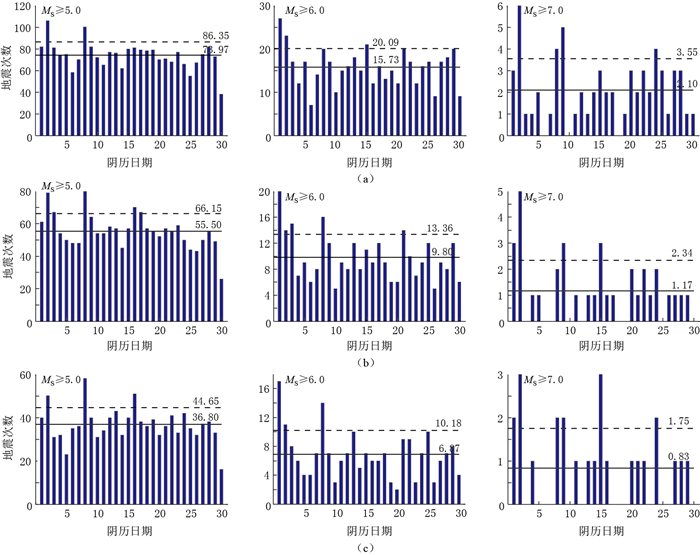
 下载:
下载:
